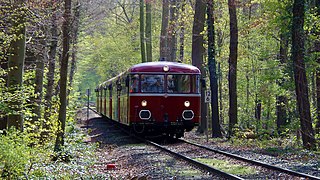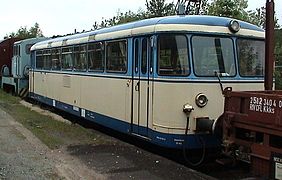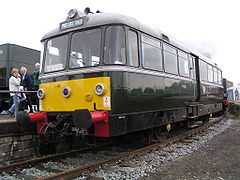Uerdinger rail bus


Uerdinger Eisenbahnbus is the colloquial term for rail buses that were developed by the Uerdingen wagon factory . These are two-axle railcars in lightweight construction with underfloor arranged diesel engines . In particular the VT 95 (later series 795 ) and VT 98 (later series 798 ) of the former Deutsche Bundesbahn are associated with this term. Their serial number began with a "9", for mechanical power transmission stood, which is why they are also referred to as VT 95.9 etc.
The VT 95-98 were used in passenger train service on branch lines that were too unprofitable for steam locomotives or diesel trains. From 1950 to 1971, 1492 locomotives were built, including all licensed constructions. Including case - and control cars , the total number of manufactured items in 3306 amounted car.
Most of these vehicles were manufactured by the Uerdingen wagon factory itself. Due to the high number of units, vehicles were also built by other wagon factories, although they could offer their own types of rail buses, such as B. MAN the MAN rail bus .
The Uerdingen rail bus is also known as the “savior of the branch lines”, since it was possible to delay or prevent line closures due to the low-cost operation with these railcars.
Types
VT 95 prototypes and series vehicles (795 series, single-engine)
From 1948 the Deutsche Reichsbahn in the United Economic Area tried to rationalize the costly and labor-intensive traffic on the branch lines. A working group drew up the specifications for a low-cost, small railcar, which should bring considerable time and cost advantages. The result was a two-axle light railcar for 40 passengers with automatic central buffer couplings of the Scharfenberg type and simple shock spring clips instead of regular buffers. Provided has been the use of components from the bus -Großserienbau; The purchase price of the vehicles should be amortized within two years.
The basic parameters were set at a meeting between representatives of the headquarters of the Deutsche Bundesbahn (HVB) and the Uerdingen wagon factory in June 1949.
Prototypes
In 1950 the Deutsche Bundesbahn put twelve single-engine prototypes in two versions into service. Ten vehicles had an axle base of 4.5 meters and an entry door on each side, which was arranged diagonally to the driver's cab on the right, the eleventh had two entry doors on each side with the same axle base. The twelfth railcar had an axle base of 6.0 meters and two entry doors on each side, as then became standard for the series vehicles.
The driver was able to initiate braking processes using the foot brake . The doors were double-leafed. The prototypes had the road numbers VT 95 901 to 911 and 912; The latter was later given the road number VT 95 9112. Matching trailer cars were put into service for the railcars.
Series vehicles
From the experience gained, the VT 95 was developed, which was supplied from 1952 by the Uerdingen wagon factory in cooperation with MAN. 557 single-engine motor vehicles of the VT 95 series and 564 associated VB 142 trailer cars with an axle base of 4.5 meters were built. The latter were supplied by various manufacturers. The WAGGONFABRIK FUCHS from Heidelberg also yielded a total of 60 Einachsanhänger the VB class 141 for the bicycle and luggage transport.
The railcars VT 95 9112 to 9269 were delivered with two skylight windows on the front. All other vehicles were delivered without these windows, as these led to the driver being dazzled when the sun was high . Later the skylights were painted over on all railcars. In 1956 the triple headlights were introduced. The railcars without skylights received an integrated third headlight in the roof, while the others used a car headlight as the third peak signal.
From the VT 95 9270 onwards, all railcars were equipped with a magnetic rail brake as standard, older vehicles were retrofitted. The vehicles have a Bussing - diesel engine and a six-speed manual gearbox . They have central buffer couplings and shock spring clips instead of buffers .
The driver operates the switch for the simplified safety driving circuit ( dead man's button ) on his driver's seat with his left hand and accelerates with a pedal. The brakes of the series vehicles were operated by a driver's brake valve . Since the driver's cab is not structurally separated from the passenger compartment , the driver's table can be closed with a wooden roller blind. The handle of the driver's brake valve located outside the roller blind is taken along by the driver when changing the cab, as is the gear selector switch.
It is very simple to set up and resembles a bus , hence the name “rail bus”: an open-plan car . The backrests of the passenger bench seats, which are perpendicular to the direction of travel in a 2 + 3 arrangement, can be folded down by the passengers as required, e.g. B. to sit in the direction of travel, and thus enable either complete rows or face-to-face seating. The lighting is done with bare incandescent lamps .
15 VT 95 rail buses with 15 VB 142 trailers were delivered to the Saarland railways in 1956 . They wore the red paintwork of the Deutsche Bundesbahn with the inscription SAAR. Contrary to normal operating practice, the VT 95 was allowed to be used in Saarland with two VB 142. With the incorporation of the Saarland into the Federal Republic, these vehicles were taken over by the Deutsche Bundesbahn.
In 1968 the vehicles received the new series number 795, the sidecar 995.
VT 98 series (series 798 and 796, twin-engine)


The VT 98 was developed from the VT 95, which was too weakly motorized for many routes with just one drive motor. The VT 98 therefore had two traction motors. Since the railcars had buffer planks with screw couplings, they could be used as towing cars to take other wagons with them or to be placed at the end of other trains for transport with external power.
Underfloor motors of the U 10 type from Büssing AG were installed in all rail bus types . This is the same diesel engine as in the Berlin double-decker buses of the type D2U . It is a six-cylinder in-line engine as a naturally aspirated diesel in a horizontal arrangement. The semi-automatic six-speed transmission of the type 6E75S was supplied by ZF Friedrichshafen AG . The electromechanical transmission was innovative at the time. It has five electromagnetic clutches that can shift six gears, two lubrication positions and various intermediate gears. The driver usually starts off in 2nd gear. To shift into the next gear, there is an intermediate stage: the electromagnets are de-energized, the engine speed drops, and then the next gear is engaged. To downshift the engine driver has to double- declutch. Instead of an accelerator pedal, these railcars have a hand throttle lever on the left of the driver's seat. This change was necessary because of the multiple traction. With the VT 98, all control impulses must be electrical in order to be able to remotely control the railcar from a second railcar or a control car.
The railcars VT 98 9531–9553 and 9571–9600 received facilities for steep sections. In addition to the existing normal compressed air brake and the magnetic rail brake, a third brake system was installed: a throttle valve in the exhaust pipe. The exhaust pipe is closed by pressing a toggle switch on the driver's desk. The exhaust gas accumulates in the engine and the engine brakes the vehicle via the transmission. Because of the high temperatures on the cylinder heads, this device was very unpopular, especially in workshops.
For these 329 railcars, 220 VB 98 trailer cars with a packing compartment, another 100 without a packing compartment and 310 VS 98 control cars were produced. Three VB 98 trailer cars were subsequently converted into VS 98 control cars. Most of the time, these railcars were used in the combination of VT + VB + VS at DB. But there were also shorter two-car units VT + VS and longer sets, up to six-car units VT + VB + VS + VT + VB + VS.
In 1968 the type number of the railcars was changed to 798, the sidecars were given the numbers 998.0-3 and control cars 998.6-9. The serial number of the control car was increased by 600 (VS 98 001 became 998 601).
Some copies have been modernized and received a special paint in white-mint green. These rail buses ran on the Chiemgaubahn ( Aschau - Prien ), as did the Ulmer Spatz vehicles . Otherwise, the rail buses kept the dark red typical of DB railcars until the end.
In 1988, 47 railcars, 23 sidecars and 45 control cars were converted to one-man operation. They received pneumatic door locking devices and payment tables for the driver. These railcars were given the series number 796.
Special design VT 97 (series 797, rack rail car)
Initially, six motor cars were designed in 1962 as rack- and- pinion cars and classified as the VT 97 series and designated as VT 97 901 to 906, the six control cars as VS 97 001 to 006. The gear drive was supplied by the Swiss Locomotive and Machine Factory in Winterthur. Due to the division of the racks, these rail buses had a wheelbase of only 5950 millimeters. The maximum speed on the ascent was 15 km / h on the rack, otherwise 90 km / h. The VT 97 operated from May 27, 1962 on the Honau – Lichtenstein ( Swabian Alb ) rack railway .
The VT 97 901 was transferred to the Passau depot at the beginning of 1964 and, due to a lack of suitable locomotives, even operated goods traffic on the Passau – Wegscheid route from 1964 to 1965 . Two more railcars were ordered for the route to Wegscheid. On January 28, 1965, a rock fall made the route impassable. The rail bus was now stationed at the Tübingen depot and received the computer-compatible vehicle number 797 901-6 on January 1, 1968. On the same date, the VT 97 902–908 were also re-designated as the 797 902–908 series. The VT 97 907 and 908 that had already been ordered came straight to the Tübingen depot after delivery in 1965.
After the cogwheel lines were abandoned, the cogwheel drive was expanded between 1970 and 1973. The vehicles were designated from January 1, 1973 as 797 501-508. After that, it was used, among other things, on the Göppingen - Boll branch line ( Voralbbahn ) until this line was also closed on May 27, 1989. Three railcars (797 502, 797 503 and 797 505) and two control cars (VS 97 604 and VS 97 605) are owned by the Friends of the Honau-Lichtenstein cog railway. V.
Used by the Deutsche Bundesbahn and Deutsche Bahn

Regular traffic
The rail buses were on almost every branch line and on many main routes in the shuttle service. Until 1999 he was deployed on the Ammertalbahn in line service at Deutsche Bahn AG from the Tübingen depot . These were twin-engine VT 98s. Most of the single-engine VT 95s were decommissioned as early as 1980. In Cologne-Nippes a 795 was still in use for railway employees until 1983.
Railway service vehicles
Several series of railway service vehicles are based on the Uerdingen rail bus. These were in the railcars after these several years worked in passenger service, in maintenance workshops built instruments. In February 1964, the prototype VT 95 906 was converted into an Indusi measuring vehicle with the new designation Series 724 . It was used by the Signalwerkstatt Wuppertal .
A few other converted Uerdingen rail buses are still in use today as rail test trains, track measuring cars, LZB measuring cars, equipment vehicles or signal service cars.
Museum vehicles
Many of these sturdy and popular vehicles were bought by railroad associations and railroad museums and are still used in museum operations today.
One in regional train - color lacquered furniture went to 2013 to the summer weekends in the tourist traffic on the Swabian Albbahn and the railway line Ulm-Sigmaringen between Ulm Hauptbahnhof and Kleinengstingen . These trips were made by the Eisenbahnbusfreunde Ulm e. V. through. They ran it as a regular regional train. In addition, the first car was marked with a sign "on behalf of the DB". Consequently, the regular DB local transport tariff or the NALDO and DING network tariffs also applied . The former Chiemgaubahn rail buses and other rail buses that were painted in the mint green color scheme of the Bundesbahn were used. This set was also called the Ulm Sparrow .
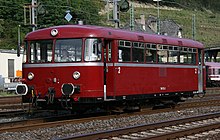
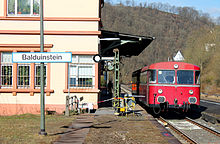
Operational museum vehicles are available from the following operators:
- Museum Railway Rahden-Uchte e. V.
- AKE railway tourism
- Vulkan-Eifel-Bahn operating company
- Hammer Eisenbahnfreunde (one of the few still operational rail buses of the VT 95 series),
- Bochum-Dahlhausen Railway Museum
- Passau Railway Friends
- German Steam Locomotive Museum
- Bavarian Railway Museum
- Upper Hessian Railway Friends (OEF)
- Historic Railway Frankfurt (HEF)
- Railbus Friends' Association (Hönnetaler Eisenbahnfreunde)
- Cologne-Bonn Railway Friends (KBEF)
- Railway friends Zollernbahn
- IG Rail Bus Seelze (ISS)
- West Mecklenburg Railway Company
- Friends of the Mainschleifenbahn
- Ammerland-Barßel-Saterland museum railway
- Museum Stoomtrein Goes-Borsele
- Zuid-Limburgse Stoomtrein Maatschappij
- Friends of the rail bus "Roter Flitzer" (formerly 5081 ÖBB, operational)
- Pfalzbahn GmbH
- Railway friends Rodachtalbahn
- Saar Mosel Rail GmbH (SMR)
Inoperable vehicles are owned by the following institutions:
- Railway Museum Dieringhausen
- Transport Museum Nuremberg (one each VT 95 and VT 98)
- German Museum of Technology Berlin (795 465-4, as an exhibit)
- Working Group on Historic Internal Combustion Locomotives (steel-sprung VT 98)
- Friends of the Honau – Lichtenstein rack railway (two VT 97)
- DGEG in Bochum-Dahlhausen (VT 95)
- Pfalzbahn GmbH (sidecar)
- Kalibahn Lower Saxony Riedel 798 632
- Hochwaldbahn eV
- Heinrichsmeyer Eisenbahndienstleistungen UG
Used by German private railways
New vehicles
Some private railways also procured Uerdingen rail buses. The Hohenzollerische Landesbahn got three railcars that corresponded to the pre-series of the VT 95 (VT 95 911). The suburban railway Wilhelmshaven had a railcar that corresponded to the serial version of the VT 95.
Most common was a type that, like the VT 98, had normal clutches but only had one engine. They were delivered to the Bentheimer Eisenbahn (one railcar), the Kleinbahn Weidenau-Deuz , the Elmshorn-Barmstedt-Oldesloer Eisenbahn (EBOE, four railcars between 1961 and 1968) and the Hersfeld Kreisbahn (three railcars and two trailer cars), the latter also being acquired a three-part set (railcar, sidecar, control car) with bellows- wagon transitions, which corresponded to the trains delivered to Spain. The EBOE railcars came to the Altona-Kaltenkirchener Eisenbahn in 1981 , two of which are still in use for special trips.
Finally, there were also two serial VT-98s on the Kahlgrundbahn .
Used vehicles
Many private railways have purchased used Uerdingen rail buses from Deutsche Bahn. Used railcars of this type were used by the railways and transport companies Elbe-Weser GmbH and AKN Eisenbahn AG in local traffic.
In 1993, Dürener Kreisbahn GmbH (DKB) bought ten VT 98s, modernized them and used them in a new white and blue paint scheme on the Rur Valley Railway until RegioSprinter took over the transport in 1995.
The VT 98 203 was transferred from the Dürener Kreisbahn to the Museumseisenbahn Hümmlinger Kreisbahn e. V. sold. The museum railway association worked the railcar with the DB number 798 514 operationally and uses it in its original paint for special trips in the Wilhelmshaven area .

Other used VT 98s were bought by Prignitzer Eisenbahn GmbH , both from Deutsche Bahn and DKB, and used in blue-red paint on their routes in Brandenburg and Mecklenburg-Western Pomerania . From 2003, however, the rail buses there were also replaced by Regio-Shuttle RS1 , only one railcar (T11) was kept ready for special trips for a while. Most rail buses have now been sold to museum or other private railways.
The German regional railway operated in 2007, the Dübener Heath Railway between Wittenberg and Bad Schmiedeberg in regular service with a Uerdinger railcar, the addition times with control car in season traffic in the years 2005 to 2008, the Niederlausitzer railroad was used. Both vehicles have been in use at the Wisentatalbahn eV association on the Schönberg – Schleiz railway line since 2016 . In addition, a former MAN industrial multiple unit acquired by AKN Eisenbahn has been in use there since 2014 , which is used together with the other two if necessary.
From December 2002 to December 2010, the Saxon-Bohemian Railway Company (SBE) also mainly used Uerdingen rail buses from the parent company HWB Verkehrsgesellschaft mbH on the Mandau Railway .
Since 2010 the Potsdam Railway Company has again been using two of the Uerdingen rail buses previously used by the Prignitzer Eisenbahn in regular operation. These are the T2 and T11 railcars. While the former was painted red again, the latter still bears the colors of the Prignitz Railway. Initially, the railcars ran Monday to Friday on behalf of the Prignitz transport company on the Pritzwalk – Putlitz route ; Prignitzer Eisenbahn operates until December 2014.
Rail bus of the railways and transport company Elbe-Weser
AKE railway tourism rail bus
Rurtalbahn GmbH rail bus
Rail bus of the German regional railway
export
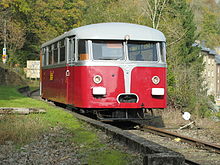

New vehicles
- Finland : The Finnish State Railways (VR, now VR-Yhtymä ) planned in the early 1950s to procure some sample copies of the type VT 95, which, however, could not be ordered due to a lack of currency.
- Yugoslavia : 10 vehicles, including one-piece and three-piece sets, were also delivered to the Yugoslav Railways in 1954 , where they became known as Šinobus . As a result, GOŠA built a total of 263 units under license in Smederevska Palanka between 1959 and 1967 . They initially ran as the 126 series , later as the 812 series (the sidecar as the 818 series). In Serbia , the last vehicles were parked in the spring 2016th
- Luxembourg : The Chemins de Fer Luxembourgeois (CFL) bought ten motor cars and ten sidecars of the prototype series in 1951, they were given the road numbers 151 to 160 and 1051 to 1060. One set has been preserved and is now used on the museum railway in the industrial and Fond-de-Gras railway park was used. An eleventh car with the number 161, it corresponded to the VT 95 series, followed in 1956 to Luxembourg.
- Mexico : In 1955, a railcar intended for GKB (VT 10.03) was lent directly from the factory via Bremen to the NdeM in Mexico from January to March and took test drives there, but no order was placed from Mexico. From April 1955 he was then employed at the GKB.
-
Austria : The Austrian Federal Railways (ÖBB) also put rail buses as class 5081 into service.
- With the abandonment of passenger traffic on the Bückeburger Kreisbahn, one of three sets of VT95 + VS95 (control car with Scharfenberg coupling) came to the Montafonerbahn. When this set was decommissioned there, it was sold to the Friends of the Cologne-Bonn Railway and used from Brühl-Vochem. Because of the high repair costs, the set was sold to the operator of the station restaurant in Frechen station and is now in the local beer garden.
- These railcars were also procured from the Graz-Köflacher Railway . After purchasing a small series, they were built under license from Simmering-Graz-Pauker and Jenbacher Werke .
- Spain : Some multi-part units were also delivered to Spain. The special feature were straight front walls with transitions between the cars. The cars ran under the series designation 591. They were sold to Portugal in 1979/1980. In 1972 one of the units was involved in the serious railway accident at El Cuervo .
- United Kingdom : In 1958, British Railways bought five copies from WMD, which operated under company numbers E79960 to E79964 until 1968. The car body was adapted to the British vehicle gauge, and the entrances were designed as central entrances. In the other main dimensions (wheelbase, length over buffers) they matched the German series vehicles. Technically, they also corresponded to the German VT 95 with a Büssing U10 engine with 150 hp.
Used vehicles
- Lebanon : Until the total shutdown of the Lebanese rail network after the civil war in 1976, some modified former rail buses of the German Federal Railroad were last in service. (798 672, 798 707, 798 879; 998 010, 998 032, 998 143, 998 153; 998 672, 998 771, 998 862, 998 876). A driving car was destroyed in a bombing in 1984.
- Turkey : Many vehicles retired from the Deutsche Bundesbahn were sold to the Turkish State Railways (TCDD).
- Uruguay : The only Uerdingen rail buses on the American continent are in Uruguay with the AFE . The last of the copies bought second-hand from the Deutsche Bundesbahn as a large series are still in regular use today.
Relatives and successors
Similar vehicles were built in the GDR as the VT 2.09 series .
The two trolleybus types ÜHIIs and ÜHIIIs as well as the line buses of the Büssing-Uerdingen 6500 T type are closely related to the Uerdingen rail bus .
The series 627 and series 628 were developed as successors in the early 1970s , but only the series 628 was produced in series from 1986 to 1995.
These railcars are now also being replaced by more modern vehicles such as Stadler RS1 (from 1996), Bombardier Talent (from 1996), Alstom Coradia LINT (from 1999) and Siemens Desiro (from 1999).
literature
- Rolf Löttgers: The Uerdingen rail bus - branch line saver and export hit . Franckh's Eisenbahnbibliothek, Franckh'sche Verlagshandlung, Stuttgart 1985, ISBN 3-440-05463-2 .
- Joachim Seyferth: Memories of the rail bus ( rail -Photo Volume 1) . Joachim Seyferth Verlag, Wiesbaden 1987, ISBN 3-926669-01-2 .
- The rail buses of the DB - VT 95/98 . EK special. EK-Verlag, Freiburg 1990.
- Rail buses of the DB - The "Uerdinger" - savior of the branch lines . Bahn Extra 5/2009, GeraMond, Munich September / October 2009.
- Jörg Hajt: Farewell to the rail bus . Heel-Verlag, Königswinter 1998, ISBN 3-89365-664-2 .
- 50 years of Uerdingen rail bus . Eisenbahnkurier Special 56. EK-Verlag, Freiburg 2000.
- Malte Werning: Rail buses - VT 95 - VT 98: railcar veterans of the 1950s . GeraMond 2001, ISBN 3-7654-7102-X .
- Jürgen-Ulrich Ebel, Josef Högemann, Rolf Löttgers: Rail buses from Uerdingen. Vol. 1., technology and history at DB, private railways and abroad . EK-Verlag, Freiburg 2001, ISBN 3-88255-221-2 .
- Jürgen-Ulrich Ebel, Josef Högemann, Rolf Löttgers: Rail buses from Uerdingen. Vol. 2, History of use of the VT 95, VT 97 and VT 98 series . EK-Verlag, Freiburg 2002, ISBN 3-88255-222-0 .
- Jürgen Krantz, Roland Meier: Everything about the rail bus . transpress-Verlag, Stuttgart 2007, ISBN 978-3-613-71313-0 .
- Christoph Riedel: Rail buses and battery-powered railcars - the last years of operation in West Germany . Podszun-Verlag, 2009, ISBN 978-3-86133-496-5 .
Web links
- Bahn-Galerie.de - series 795–798
- Pictures of the VT 95 (Class 795) in the European Railway Picture Gallery
- Pictures of the VT 98 (Class 798) in the European Railway Picture Gallery
- www.roter-brummer.de Comprehensive presentation of German rail buses
- Ulm Sparrow
- fsbmenden.de, Friends of Rail Bus e. V Menden
- Working Group on Historic Internal Combustion Locomotives ( Memento from August 4, 2007 in the Internet Archive )
- The Kasbachtal Railway in Rhineland-Palatinate
- Interest group for rail bus Seelze e. V.
- Pictures of trains in 2009 - 998, rail bus - 150 years of the Bavarian Eastern Railway
- Friends of Rail Bus e. V.
Individual evidence
- ↑ Michael Dostal and others: Introduction of DB vehicles. Inventory, development, programs . GeraMond, Munich 2019, ISBN 978-3-7654-7529-0 , p. 50 .
- ↑ Series production: VT 95 91 , VT 97 and VT 98 . VT 95–98 Uerdingen rail bus. In: Railway Journal . Special issue, no. 1 , 2012, p. 31 .
- ↑ Between Husum and Radolfzell . VT 95–98 Uerdingen rail bus. In: Railway Journal . Special issue, no. 1 , 2012, p. 42 .
- ^ Hümmlinger Kreisbahn: special trips from Wilhelmshaven to Sande. In: Railway courier. Retrieved August 4, 2013 .
- ^ The vehicles of the Wisentatalbahn. Förderverein Wisentatalbahn eV, 2018, accessed on March 4, 2018 .
- ↑ Egbert Peinhopf: railroads in Istria - Then and Now . Bahnmedien, Vienna 2017. ISBN 978-3-9503921-8-0 , p. 102.
- ↑ Transfer of the KBEF “Montafoner” to Frechen on youtube.com
- ^ Walter Rothschild, in: HaRakevet, July 1990, Issue 9








